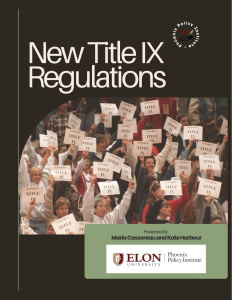Education Policy
Education Policy
Early Childhood Education
Assessing The Implementation of QRIS Standards Within Early Childhood Education
By: Emma Bach and Savannah Willette
Published: Fall 2022
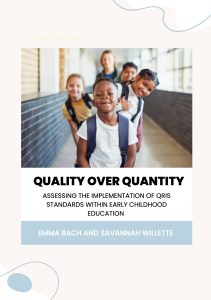 Abstract: Quality education lays the foundation for a good society. Having a strong educational foundation helps a child grow and achieve at above average levels in their educational and personal careers. Children who receive a strong early childhood education are less likely to be placed in special education, more likely to graduate high school and receive higher salaries. By investing more money into setting children up for success now, we can spend less money down the road. Economic research shows that return on investment for early childhood education ranges between $4- $13 for every $1 spent. Children who come from low income families and have access to quality education are more likely to graduate college and have bigger salaries at age 26. Not just providing early childhood education, but high quality education is even more important. The following policy brief looks at the Quality Rating and Improvement System (QRIS), a general term used to describe a system that helps parents understand quality of childcare programs, and the benefits that come from federalizing this program.
Abstract: Quality education lays the foundation for a good society. Having a strong educational foundation helps a child grow and achieve at above average levels in their educational and personal careers. Children who receive a strong early childhood education are less likely to be placed in special education, more likely to graduate high school and receive higher salaries. By investing more money into setting children up for success now, we can spend less money down the road. Economic research shows that return on investment for early childhood education ranges between $4- $13 for every $1 spent. Children who come from low income families and have access to quality education are more likely to graduate college and have bigger salaries at age 26. Not just providing early childhood education, but high quality education is even more important. The following policy brief looks at the Quality Rating and Improvement System (QRIS), a general term used to describe a system that helps parents understand quality of childcare programs, and the benefits that come from federalizing this program.
PK – 12 Education
Fenced Out Of Education: Housing Inaccessibility & Educational Gerrymandering
By: Samantha Hinton and Danny Nickel
Published: Spring 2023
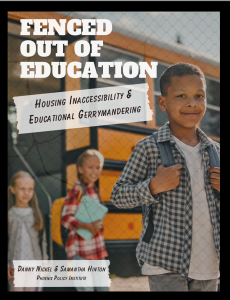 Abstract: The right to a public education is not explicitly mentioned in the United States Constitution or its 27 amendments. However, via the power granted to states by the 10th Amendment, all 50 states have taken it upon themselves to enumerate a right to education within their individually governing constitutions. Often called “the great equalizer” of our society, every child is required to receive and be provided an education. Nonetheless, disparities in funding and overall quality of education are incredibly prevalent– particularly in terms of income inequality. Research has shown that across America, educational gerrymandering is used to cluster low-income families into single school districts while simultaneously keeping housing options in higher-income school districts inaccessible (Spurrier et al. 2021). Housing inaccessibility has significant impacts on the amount of allotted funding and the educational outcomes of students. This brief analyzes current practices of educational gerrymandering to create policy solutions that promote greater equity throughout American school districts.
Abstract: The right to a public education is not explicitly mentioned in the United States Constitution or its 27 amendments. However, via the power granted to states by the 10th Amendment, all 50 states have taken it upon themselves to enumerate a right to education within their individually governing constitutions. Often called “the great equalizer” of our society, every child is required to receive and be provided an education. Nonetheless, disparities in funding and overall quality of education are incredibly prevalent– particularly in terms of income inequality. Research has shown that across America, educational gerrymandering is used to cluster low-income families into single school districts while simultaneously keeping housing options in higher-income school districts inaccessible (Spurrier et al. 2021). Housing inaccessibility has significant impacts on the amount of allotted funding and the educational outcomes of students. This brief analyzes current practices of educational gerrymandering to create policy solutions that promote greater equity throughout American school districts.
Access To Educational Disability Resources
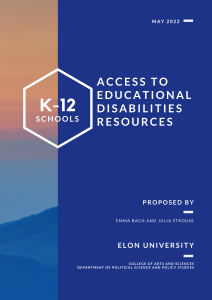 By: Emma Bach and Julia Strouse
By: Emma Bach and Julia Strouse
Published: Fall 2022
Abstract: In the United States, public K-12 education is available to all students, but the issue of accessibility to equal and quality education is being called into question. Specifically, looking at kids who struggle with learning disabilities, such as ADHD, dyslexia, dysgraphia, and ADD. A lack of educational disability resources also leads to an increase in the achievement gap of students. Through an analysis of the policy goals and alternatives, it was proved that the most effective solution is to strengthen the current existing programs in K-12 public schools in the United States alongside a combination of increased funding and oversight from the local Departments of Education.
Censorship on Shelves: Banned Books in America
By: Tori Kelleher and Larissa Moelber
Published: Fall 2022
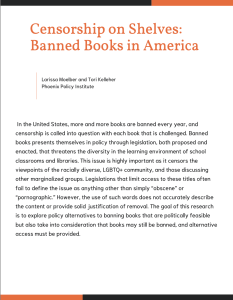
Abstract: In the United States, more and more books are banned every year, and censorship is called into question with each book that is challenged. Banned books presents themselves in policy through legislation, both proposed and enacted, that threatens the diversity in the learning environment of school classrooms and libraries. This issue is highly important as it censors the viewpoints of the racially diverse, LGBTQ+ community, and those discussing other marginalized groups. Legislations that limit access to these titles often fail to define the issue as anything other than simply “obscene” or “pornographic.” However, the use of such words does not accurately describe the content or provide solid justification of removal. The goal of this research is to explore policy alternatives to banning books that are politically feasible but also take into consideration that books may still be banned, and alternative access must be provided.
Higher Education
Hazing on College Campuses: Who is Responsible
By: Molly Frank and Baden Eaton
Published: Spring 2024
Abstract: Elon University defines hazing as “any activity expected of someone who is joining a group (or who is trying to maintain full status in a group) that humiliates, degrades or risks harming that person financially, emotionally, or physically, regardless of the person’s willingness to participate,”(1). This definition is often regarded as the standard for federal and state law and many universities’ codes of conduct. The question is, why do students haze who is behind it? When students are suspected of hazing, what happens to them and the organization they are a part of? Over recent years, hazing deaths have grown drastically, with over 100 people from January of 2000 dying, and 60 of these deaths were connected to a substance, most commonly alcohol (2). There are rules around hazing at many schools, but just like any rule, they are disobeyed; the situation after that leaves many students, schools, and parents wondering.
New Title IX Regulations
By: Maria Cassereau and Kate Harbour
Abstract: Title IX is a Federal Law that was created in the 1970s to protect students from sex-based discrimination. As views on gender and sex equality continue to change, Title IX has seen significant changes and will continue to see them. Under the Biden administration new regulations were created to better safeguard members of the LGBTQIA+ community, and continue to protect victims of sexual abuse. These new regulations have been met with harsh criticism and lawsuits. This policy memo will explore what Title IX is, what the existing legislation is, how the new regulations would change Title IX, and how these lawsuits halt the implementation of new regulations.

